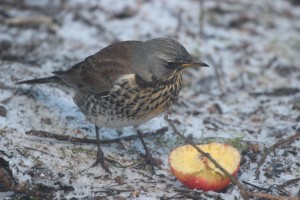 At first light the small birds such as great, blue and coal tits, chaffinches and greenfinches, were already at the various garden feeders. An added bonus was the long-tailed tits, chattering away as they always do, as they tackled the suet balls. No blackbirds I thought as I topped up the various feeders and liberally scattered the mixed grain on the four bird tables. Then, last, out went the sliced apples and before I had reached the back door the blackbirds were at them. A while later I glanced out and there were eight blackbirds and, as always, I was intrigued by the variation in the birds’ plumage. Some were adult males, black feathers almost gleaming and contrasting with the bright yellow beaks. In contrast, presumably adult females or juvenile birds from last year, were the brown speckled blackbirds.
At first light the small birds such as great, blue and coal tits, chaffinches and greenfinches, were already at the various garden feeders. An added bonus was the long-tailed tits, chattering away as they always do, as they tackled the suet balls. No blackbirds I thought as I topped up the various feeders and liberally scattered the mixed grain on the four bird tables. Then, last, out went the sliced apples and before I had reached the back door the blackbirds were at them. A while later I glanced out and there were eight blackbirds and, as always, I was intrigued by the variation in the birds’ plumage. Some were adult males, black feathers almost gleaming and contrasting with the bright yellow beaks. In contrast, presumably adult females or juvenile birds from last year, were the brown speckled blackbirds.
Then, suddenly, there was a different, larger bird with them but tearing into an apple in the same enthusiastic way as the blackbirds – a fieldfare. There was only one of them and, as always, I wondered why a single bird would come into gardens. After all they migrate from Scandinavia to winter with us in large flocks and will mingle with large numbers of redwings. Yet suddenly a single bird takes it on itself to invade a garden and feed on its own as far as other fieldfares are concerned. Fieldfares are large, plump thrushes with rather long tails and have grey heads with dark streaks on the crown. They have long pale grey rumps, chestnut backs and black tails and flight feathers. One conspicuous feature is the yellow-orange breast that is heavily spotted. One characteristic in flight is the sudden flash of white from the underwings and this is very conspicuous and can be seen from some distance away especially when a number of birds take flight.
Fieldfares have a wide variety of Scots names such as Feltie, Grey Thrush, Screech Bird or Hill Bird. There are two Gaelic names with commoner one Uiseag sneachda meaning Lark of the Snow. Most of these names refer to the fieldfare’s colours or to its harsh call “chack-chack-chack”. When the flocks first descend from Scandinavia they generally attack the crop of rowan berries which has been particularly heavy in the last two years. After the rowan berries they will go for other berries, such as holly, but eventually the berries of any sort are depleted and the birds then have to move on, both south and east, to find food for the winter months. The largest numbers arrive between mid-October to mid-November and then normally depart between March and May. The fieldfare is one of Scotland’s rarest breeding birds with not more than five pairs attempting to breed in most years. In marked contrast, the total wintering numbers are remarkable and are estimated at 100,000 to 150,000 but on passage it can reach a staggering 1.5 million fieldfares.
With “my” bird in the garden I reached for the camera, a Canon digital with a 100 to 400 mm lens although the make does not matter. Enthusiastic photographers will be aghast that I photographed the bird through a window of the house but the result satisfied me. What was interesting was the antics of the bird as it was completely unaware of my presence but almost seemed to pose for the camera. The fieldfare stayed for only two days and was then gone as suddenly as it had appeared, perhaps to join its fellow migrants moving south or east.
Tags: highland flora
